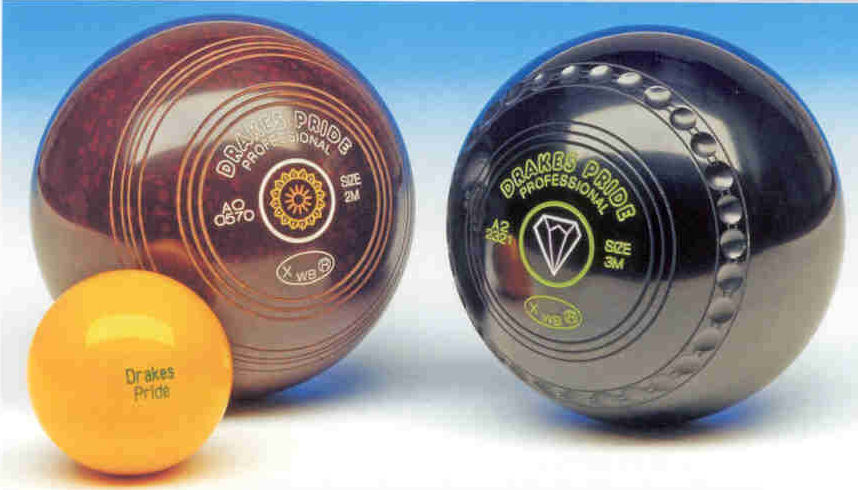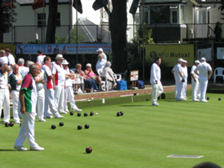Article 5 - Composition Bowls
ARTICLE 5 - Composition Bowls
(Originally published in 1998 and revised in 2009)
My last article covered the manufacture of "Woods" for this
article I will cover the manufacture of Composition Bowls -
confusingly still known as "Woods"!!
We have to thank the games spread overseas for the introduction
of Composition Bowls. As the sport developed in the Southern
Hemisphere, which enjoys a hotter climate than the U.K., it quickly
became apparent that Lignum Vitae was not a suitable material for
bowls to be made from, basically it warped and cracked.
The Australian, billiard, company Alcock & Co. employed Hr.
W. D. Hensell who in 1918 with Dunlop Rubber Co. produced the first
Ebonite bowls. Mr. Hensell set up his own business turning the
Dunlop Rubber Co. material into bowls. This proved to be so
successful that Lignum Vitae bowls were no longer imported into
Australia. In the 1930's Dunlop Rubber Co. decided to not only make
the material but also to do their own turning and finishing.
Which precipitated Mr. Hensell and his son Ray to search for a
replacement material and so after many failures the company was
able in April 1931 to produce the first successful Phenol
formaldehyde Composition Bowl.(Note for coloured bowls Melamine is
the preferred material). Since that date the development of the
modern bowl has progressed forward but still uses the Phenol
formaldehyde as the basis. What a lot of bowlers do not appreciate
is the science and engineering that goes into the production of
their set of bowls. Very few sports have such high specifications
for their equipment, which can then be purchased so cheaply.
Whilst I hear you all say - he would say that his company
manufactures bowls - just bear in mind the information in the
following paragraphs.
To start at the beginning, the phenolic powder has to be
produced and this is a science and a skill in itself. All
manufacturers use powders with different specific gravities to
achieve their desired weights for their various models. So not only
does the powder manufacturer have to design the powders to suit the
moulders requirements for the flow characteristic, colour, surface
finish, etc. that they require, but they also have to ensure that
the specific gravity meets the specifications and all these
specifications must be consistently met.
The machining, of the material, really relates to the final
manufacturing of the bowls but the Powder Producer has to take this
into consideration as well as the final surface finish and, as
already mentioned the colour. This last specification may surprise
a few, when they consider that the majority of bowls are black -
but there are many shades of black achievable from a very, very
dark grey to a jet black.
After the ingredients are blended the initial process to produce
the Powder can commence which involves both heat and pressure. The
chemical bonding process begins at this point (but then it is
stopped), and the resulting "Cake" is ground to the powder size
specified by the moulder. To ensure, at all stages of production,
the very stringent specifications laid down are achieved, the
producers have their own in-house quality control laboratory. This
enables them to test for conformity to the demands of the moulders
and as an example of this, the main U.K. supplier of the powder has
met with the requirements laid down to achieve BS5750.
All the mixes are checked to ensure that grain size and mix are
correct. The final check for this is also made for the blended
powder before despatching it to the moulder. Checking the specific
gravity is correct is a regular feature throughout the production
and the specific gravity can be altered to ensure conformity to the
requirements of the customer. They even produce small mouldings of
the final blend, which they can machine to check the rigidity and
shrinkage so that they can ensure that they fully meet the demands
and specifications of the moulder.
The next stage is the moulding of the blank, which is again a
very specialist task. Even some of the U.K. top moulding companies
cannot achieve the desired results. I believe it is still true that
the moulded "blank" for a bowl is still the largest solid mass of
phenol compound moulded successfully.
As the basic blend powder is comparatively expensive, we, and
our competitors, have moulds of different sizes to suit the
different models and size of bowl which we produce. This avoids
producing too much waste during the turning operation. Basically
however the process starts by taking the specified quanity of
phenolic thermoset powder, which is then carefully measured out to
ensure that the exact amount of powder is used for that particular
mould.
Before the powder is placed into the
mould it is pre-heater which ensures that the moisture is removed
and that the "Cake" is heated right through. This also restarts the
chemical bonding process and thus helps reduce the time required in
the mould.
After the pre-heating is completed the "Cake" is put into a
computer controlled high tonnage compression moulding press. The
platens and mould of which, are heated to a surprisingly high
temperature. The "Cake" which is then pressed into the final shape
remains in the press for some time to allow the 'Cake' to be fully
baked! It then emerges as a "blank" which we can use in our
computer controlled lathes.
However, this isn't the final part of the moulding process, the
blanks now have to be left to cool under controlled conditions so
that the full cure can be successfully completed and then they are
sonic checked for voids before being ready for use. We also at
Drakes Pride like to leave them to "settle" so that any moulding
stresses will have gone before we turn same.
You will now realise, the moulding processes are also highly
complex and the skill required to ensure the gases that develop
during the chemical bonding and pressing are released and not
trapped in the mould. This process has been improved and developed
over the years.
As already mentioned there are very few moulders who have the
skill or the knowledge to produce these very large mouldings and as
such they too have had to have in-house laboratory testing which is
specific to their requirements. We are now at the stage were a
blank is available for the manufacturers to turn their models of
bowls from.
Drakes Pride was the first company to use computer controlled
turning centres in the manufacture of bowls and this required in
1979/80 the help of Liverpool University Computer and Mathematics
Departments to be able to produce the required geometric shapes.
The programmes developed by each manufacturer for use on their
C.N.C. equipment require skilled and highly trained specialists to
not only, initially, write them but maintain them. All the
manufacturers now use computer controlled lathes and so the bowls
produced to-day are made to higher specifications and tolerances
than over before. This in turn has put further pressure on the
moulders and the powder producers to achieve tighter and tighter
specifications.
When the blanks are taken from our
store for turning, the first of many inspection, is carried out. To
ensure that the blanks issued are consistent for weight, and an
initial bowl is turned to confirm that the bias settings on the
machine are correct for that batch production to be run off. During
the production each turned blank is checked for weight, conformity
and further bias tests will be carried out. Bowlers would recognise
the product as it comes off the lathe but finishing processes are
then required such as engraving of the brand, model, serial number,
W.B.B. Stamps(now World Bowls Ltd. stamp), etc.. From our
manufacturing the serial number lets us trace back each individual
set of bowls not only to the day they were produced, but also to
the operator who turned them, the operator who engraved them and
also which particular batch of blanks was used in the manufacture.
This is all part of our quality control.
During the finishing process examination and the testing is done
and whilst the W.B.B.(now World Bowls Ltd.)allows a tolerance of
15gms within a set, we only allow ourselves a maximum of 8gms
tolerance and our target is always to be considerably less than
that.
Bias testing on the table is something, that as you know, I
could write about for a long time, suffice to say at this point,
that all the acts of bowls in their final process are table tested
to the guide-lines an laid down by the W.B.B.(now to the
regulations laid down by World Bowls Ltd.)
You will therefore now perhaps realise that bowls and the work
involved in the manufacture of bowls, is more complicated than you
may have imagined, and why initially I suggested that they were a
very cheap sporting item. I hope you will now appreciate the true
value of your bowls. The W.B.B.(now WB for World Bowls Ltd.)stamp
is for a 10 year period (which includes the year of issue). One
should remember that for outdoor play were top dressing and gritty
fertilisers are used, the specified bias may not remain true. Also
when a bowler plays with just a pair of bowls they tend to use the
same pair. After a few years that pair of bowls will almost
certainly run differently to the other pair that have not be used..
So taking your bowls for re-testing every 5 years should be
considered by bowlers especially those who who are keen on their
sport and play regularly, otherwise every 10 years is sensible and
should be recognised by the National governing bodies. At that time
the bowls can be rebuffed/repainted so that their condition remains
good. Also, like all other pieces of sporting equipment bowls do,
believe it or not, become superseded by the newer products. The
newer bowls are not only made too much higher specifications but
will be turned too much tighter tolerances.
The newer models of bowls are designed for specific purposes,
e.g. the UK Drakes Pride Professional are the bowls specifically
designed by my company, for indoor and outdoor use, whilst our
Melbourne model( replaced in 1998 by the Professional Plus which
has subsequently be superseded by the Jazz)is the one designed for
outdoor U.K. greens. With the Advantage model design for indoor
usage. If a player used the Melbourne Model(now the Jazz) on an
indoor green the player, they would not be using the type of bowl
which has been "tuned" to the current indoor playing surfaces, it
may, however suit their style of play!!

Drakes Pride Speckled Brown &
Black phenolic material

Drakes Pride Coloured Bowls 2010
using melamine material
(Since 2010 the range of colours has been greatly increase and
there are now really too many to show!! see www.drakespride.co.uk
for current range of colours available)
(Since the World Bowls Board,now World
Bowls Ltd, meeting in 2000 coloured bowls have been allowed. Prior
to that decision only Black or Brown bowls could be used. Phenolic
material has for coloured bowls been replaced by Melamine as it has
better UV stability but Melamine can really only be used for Heavy
weight models as its basic specific gravity is high.)
© Peter Clare 2010 © E.A. Clare & Son Ltd. 2018 This article
can only be used in part or whole with permission of E.A. Clare
& Son Ltd.

